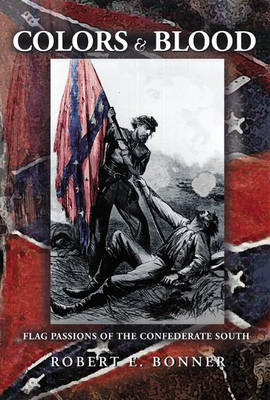
Colors and Blood
Flag Passions of the Confederate South
Seiten
2002
Princeton University Press (Verlag)
978-0-691-09158-7 (ISBN)
Princeton University Press (Verlag)
978-0-691-09158-7 (ISBN)
- Titel ist leider vergriffen;
keine Neuauflage - Artikel merken
Depicts a pervasive flag culture that set the emotional tone of the Civil War in the Union as well as the Confederacy. This book explores how the rebel flag gained its power to inspire and repel. It shows how the Confederacy sustained itself for as long as it did by cultivating the allegiances of countless ordinary citizens.
As rancorous debates over Confederate symbols continue, Robert Bonner explores how the rebel flag gained its enormous power to inspire and repel. In the process, he shows how the Confederacy sustained itself for as long as it did by cultivating the allegiances of countless ordinary citizens. Bonner also comments more broadly on flag passions - those intense emotional reactions to waving pieces of cloth that inflame patriots to kill and die. "Colors and Blood" depicts a pervasive flag culture that set the emotional tone of the Civil War in the Union as well as the Confederacy. Northerners and southerners alike devoted incredible energy to flags, but the Confederate project was unique in creating a set of national symbols from scratch. In describing the activities of white southerners who designed, sewed, celebrated, sang about, and bled for their new country's most visible symbols, the book charts the emergence of Confederate nationalism. Theatrical flag performances that cast secession in a melodramatic mode both amplified and contained patriotic emotions, contributing to a flag-centered popular patriotism that motivated true believers to defy and sacrifice.
This wartime flag culture nourished Confederate nationalism for four years, but flags' martial associations ultimately eclipsed their expression of political independence. After 1865, conquered banners evoked valor and heroism while obscuring the ideology of a slaveholders' rebellion, and white southerners recast the totems of Confederate nationalism as relics of the Lost Cause. At the heart of this story is the tremendous capacity of bloodshed to infuse symbols with emotional power. Confederate flag culture, black southerners' charged relationship to the Stars and Stripes, contemporary efforts to banish the Southern Cross, and arguments over burning the Star Spangled Banner have this in common: all demonstrate Americans' passionate relationship with symbols that have been imaginatively soaked in blood.
As rancorous debates over Confederate symbols continue, Robert Bonner explores how the rebel flag gained its enormous power to inspire and repel. In the process, he shows how the Confederacy sustained itself for as long as it did by cultivating the allegiances of countless ordinary citizens. Bonner also comments more broadly on flag passions - those intense emotional reactions to waving pieces of cloth that inflame patriots to kill and die. "Colors and Blood" depicts a pervasive flag culture that set the emotional tone of the Civil War in the Union as well as the Confederacy. Northerners and southerners alike devoted incredible energy to flags, but the Confederate project was unique in creating a set of national symbols from scratch. In describing the activities of white southerners who designed, sewed, celebrated, sang about, and bled for their new country's most visible symbols, the book charts the emergence of Confederate nationalism. Theatrical flag performances that cast secession in a melodramatic mode both amplified and contained patriotic emotions, contributing to a flag-centered popular patriotism that motivated true believers to defy and sacrifice.
This wartime flag culture nourished Confederate nationalism for four years, but flags' martial associations ultimately eclipsed their expression of political independence. After 1865, conquered banners evoked valor and heroism while obscuring the ideology of a slaveholders' rebellion, and white southerners recast the totems of Confederate nationalism as relics of the Lost Cause. At the heart of this story is the tremendous capacity of bloodshed to infuse symbols with emotional power. Confederate flag culture, black southerners' charged relationship to the Stars and Stripes, contemporary efforts to banish the Southern Cross, and arguments over burning the Star Spangled Banner have this in common: all demonstrate Americans' passionate relationship with symbols that have been imaginatively soaked in blood.
Robert E. Bonner is Assistant Professor of History at Michigan State University.
List of Illustrations and Tables, xiii Acknowledgments, xi Introduction: Waving Colors and Boiling Blood, 1 1. The Stars and Stripes of Senator Davis. A Prologue, 8 2. The Standards of State Resistance, 19 3. Selecting and Singing a New Constellation, 39 4. Blood Sacrifice and the Colors of War, 67 5. The Southern Cross and Confederate Consolidation, 96 6. Treason's Banner and the Colors of Loyalty, 125 7. Conquered Banners, Furled and Unfurled, 153 Notes, 179 Index, 213
| Erscheint lt. Verlag | 1.9.2002 |
|---|---|
| Zusatzinfo | 3 tables. 36 halftones. |
| Verlagsort | New Jersey |
| Sprache | englisch |
| Maße | 152 x 235 mm |
| Gewicht | 510 g |
| Themenwelt | Geschichte ► Allgemeine Geschichte ► Neuzeit (bis 1918) |
| Geisteswissenschaften ► Geschichte ► Hilfswissenschaften | |
| Geisteswissenschaften ► Geschichte ► Regional- / Ländergeschichte | |
| Geschichte ► Teilgebiete der Geschichte ► Militärgeschichte | |
| Sozialwissenschaften ► Soziologie | |
| ISBN-10 | 0-691-09158-7 / 0691091587 |
| ISBN-13 | 978-0-691-09158-7 / 9780691091587 |
| Zustand | Neuware |
| Haben Sie eine Frage zum Produkt? |
Mehr entdecken
aus dem Bereich
aus dem Bereich
Europa 1848/49 und der Kampf für eine neue Welt
Buch | Hardcover (2023)
DVA (Verlag)
CHF 67,20
Giordano Bruno - ein ketzerisches Leben
Buch | Hardcover (2024)
C.H.Beck (Verlag)
CHF 41,85


